|
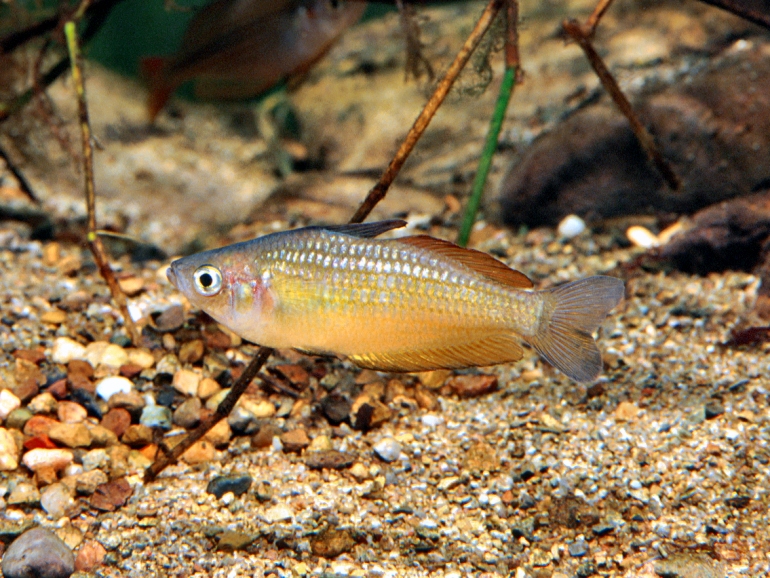 |
Melanotaenia eachamensis [Lake Eacham] - photo© Gunther Schmida |
Allen and Cross, 1982
Lake Eacham Rainbowfish
Species Summary
Melanotaenia eachamensis is a small species that may reach a maximum size of 8 cm SL, but are usually less than 6 cm SL. Sexual maturity occurs at about 2-3 cm for both sexes. Males can be distinguished from females on the basis of differences in colouration and shape of the dorsal, anal and ventral fins. The original males collected from Lake Eacham have an overall bronze body colouration. The first dorsal fin is jet black while the second dorsal and anal fins have a maroon red colouration. Females are rather plain compared with males and have smaller more rounded dorsal and anal fins.
Gerald Allen collected the Lake Eacham rainbowfish in 1978 and described as Melanotaenia eachamensis in 1982, although it was considered to be closely related to the widespread Melanotaenia splendida. Allen and Cross described the new species on the basis of differences in colour and body shape from surrounding populations of M. splendida. In his original description of M. eachamensis, Allen points out this very close relationship, and makes clear that it is defined as being separate only because it falls outside the range of parameters for M. splendida on several counts.
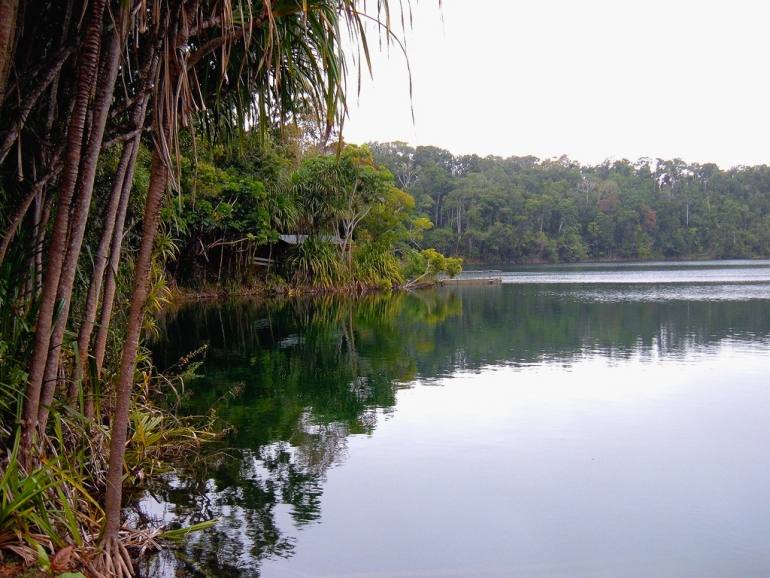 |
Lake Eacham - photo© Allan Travers |
Distribution & Habitat
Melanotaenia eachamensis were initially found in Lake Eacham, a 43 ha crater lake located on the Atherton Tablelands about 40 km south-west of the north Queensland town of Cairns. The lake has a northeast-southwest length of around 1.5 km and 1 km wide. Water in the lake is supplied entirely from the catchment area within the crater rim. The water of the lake is neutral with a low level of dissolved salts, with water temperatures between 18-28°C. The lake is permanent and deep, and fluctuates seasonally with a maximum depth of 65.5 metres during the wet season.
There are a number of volcanic crater lakes or lake remnants located on the Atherton Tablelands including Lynch's Crater, Strenekoff's Crater, Mobo Crater, Bromfield Swamp, Lake Barrine, Lake Eacham and Lake Euramoo. Three of these volcanic lakes (Eacham, Barrine and Euramoo) occur within close proximity of each other. Lake Euramoo has a relatively small catchment area of about 4500 m² with no inflow or outflow channels. The lake has a water depth averaging around 20 metres in the northern end and 16 metres in the southern end, though there are seasonal fluctuations in water depth of between 2 and 3 metres. Lake Barrine is on average 67 metres deep. It is about 1 km in diameter, has a shoreline of almost 4.5 km and is the largest of the natural volcanic lakes in the area. The surrounding area of both Lake Eacham and Lake Barrine contain creeks that flow into Tinaroo Dam (Barron River) but are not associated with the lakes themselves. Both of these lakes are very close to the impoundment area of Tinaroo Dam into which Wright Creek and Congoo Creek flow. Lake Barrine has flood-flow connections to Toohey Creek, an upper tributary of the Mulgrave River.
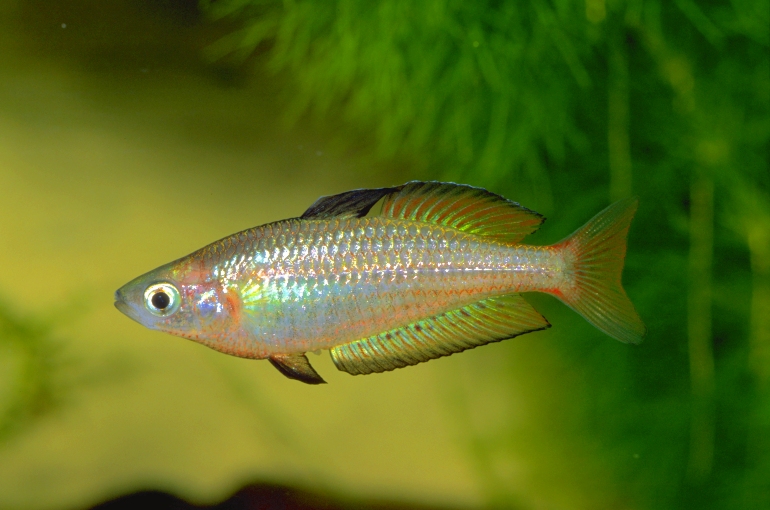 |
Melanotaenia eachamensis [Lake Euramoo] - photo© Neil Armstrong |
Small freshwater fish species had been reported from Lake Eacham as early as 1925. The first report of rainbowfishes in Lake Eacham, however, was in 1965 by members of the Townsville Aquarium Society. They were generally considered not to be as brightly coloured as other rainbowfishes from the coastal regions. There is however, no record of them having being maintained in the hobby in those early years. Allen and Cross's description of the Lake Eacham rainbowfish helped to stimulate interest in keeping the fish and fortunately a few specimens were collected for the aquarium hobby in 1980 and 1982 before they disappeared from the lake and were still being maintain by some hobbyists, otherwise this fish would have been lost forever.
Surveys of Lake Eacham in 1973, 1974 and 1978 revealed the existence of a rainbowfish along with a hardyhead (Craterocephalus stercusmuscarum) and a gudgeon (Mogurnda mogurnda). Melanotaenia eachamensis were abundant within the lake at the time, but during surveys in 1983, 1984 and 1985 four native fish species (Amniataba percoides, Glossamia aprion, Nematalosa erebi and Toxotes chatareus) were found in the lake. All these fish were presumed to have been translocated to the lake by person or persons unknown.
In 1987, Barlow et al. surveyed the lake but failed to locate any rainbowfishes, although the four introduced species were plentiful. Apart from the complete absence of M. eachamensis, the survey also failed to locate any gudgeons or any specimens of the native crayfish (Cherax cairnsensis), which had been very abundant in the lake in the early 1980's. Thus, two of the three fishes (and potentially a crayfish as well) naturally occurring in the lake disappeared during the same period that four translocated native fishes established breeding populations there.
As a result of the 1987 survey, M. eachamensis was declared "extinct in the wild" (some remained in captivity) at the 1987 Australian Society for Fish Biology Conference. Thus, within a few years of its formal recognition, the Lake Eacham rainbowfish was regarded as the first freshwater fish in Australia to have become extinct since European settlement. This extinction was attributed to a harmful interaction with the translocated species, in particular predation by the mouth almighty (Glossamia aprion). Although other rainbowfish species coexist with the translocated species elsewhere in northern Australia, it was assumed that being isolated from predators, M. eachamensis was unable to survive.
In addition to the above translocations, Lates calcarifer were collected there in 1990-1991. Hephaestus fuliginosus and M. splendida have also been translocated there and are still present. Ironically, M. splendida are now present in large numbers and another species, believed to be an exotic has also been observed. All these fish species have been stocked into the lake unofficially. The natural condition of the lake has also declined and sadly it is no longer the pristine lake it once was.
Immediately after the "extinct-in-the-wild" announcement in 1987, members of the Australia New Guinea Fishes Association (ANGFA) at their first national conference in Sydney undertook a survey of members throughout Australia, which revealed the existence of a number of small captive populations of M. eachamensis. These stocks were designated as the 'Bowman' and 'Tappin' populations. ANGFA instigated a captive-breeding program known as "Project Eachamensis" to stimulate and actively encouraged the establishment of new captive populations. Within two years, numerous 'Bowman' and 'Tappin' populations were established in the Australian hobby. In addition, eggs were sent to North America and Europe where populations were established, and the species was considered secure in captivity.
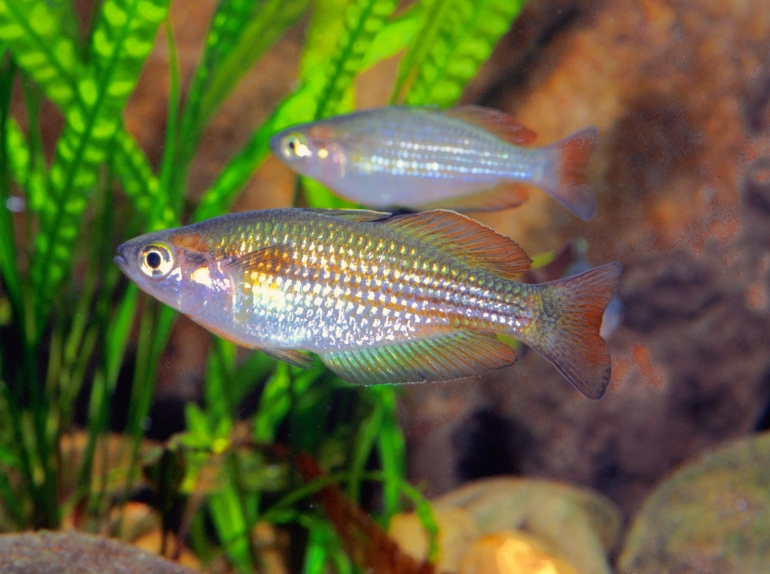 |
Melanotaenia eachamensis [Dirran Creek] - photo© Gunther Schmida |
During 1988 ANGFA member, David Liddle was exploring a number of streams on the Atherton Tablelands looking for rainbowfishes and discovered an 'eachamensis' look-alike in Dirran Creek (an upland tributary of the North Johnstone River), located about 22 km south of Lake Eacham. Another unusual rainbowfish species was also found in Lake Euramoo, a crater lake situated about 14 km north of Lake Eacham. Specimens from both these sites were subjected to genetic investigation and were found to be identical to the Lake Eacham rainbowfish.
Using an analysis of morphological and meristic characters, Pusey et al. (1997) believed M. eachamensis to be even more widespread, occurring in many upland and several lowland tributaries and reaches of the North and South Johnstone Rivers; in upland tributaries of the Herbert River; upper Tully River and the upper Daintree River. Subsequent genetic work (Zhu et al. 1998, McGuigan et al. 2000, McGuigan 2001, Hurwood and Hughes 2001) suggested that at least some of these occurrences were not M. eachamensis but either unusual variants of M. splendida, M. utcheensis or populations displaying genes of more than one species.
Rainbowfishes from Utchee Creek, a tributary of the South Johnson River, had long been recognised by rainbowfish enthusiasts as being different, although thought to be M. splendida. The above mentioned research found that most of the specimens studied from this stream were phenotypically indistinguishable from M. eachamensis. However, additional research indicated that the 'Utchee Creek' variety was indeed a distinct species, and they were formally described as Melanotaenia utcheensis, with populations known from Utchee, Fisher, Rankin and Short Creeks in the North and South Johnstone catchments (McGuigan, 2001).
Genetic analysis also revealed M. eachamensis occurred in Bromfield Swamp in the North Johnstone River headwaters (McGuigan, 2001). Bromfield Swamp occupies a partially breached crater and is very shallow. Bromfield Swamp is an explosion crater, from which water drains from an outlet on the east side. The swamp, which is 500 metres in diameter is approximately 45 metres below the rim of the crater, and was once surrounded by tropical rainforest.
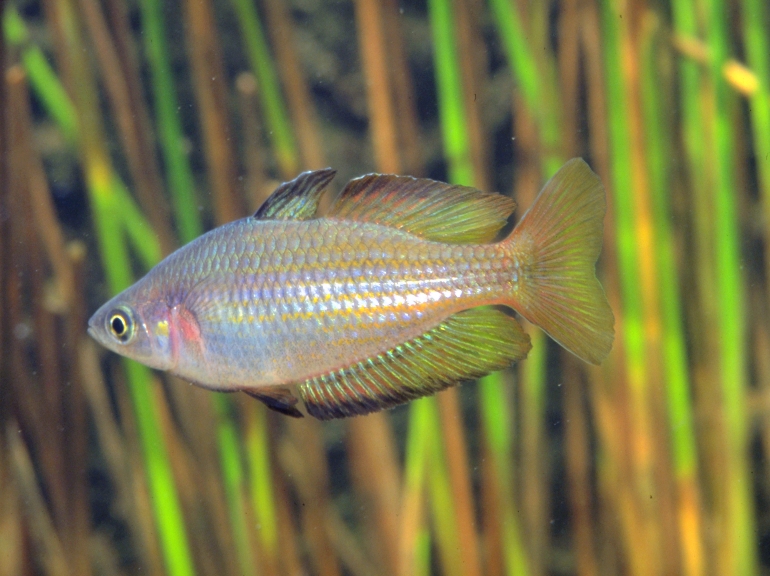 |
Walkamin "eachamensis" - photo© Gunther Schmida |
Zhu et al. (1998) also found populations that contained a mixture of genes from M. eachamensis and M. splendida, in other locations such as an irrigation channel from Tinaroo Dam (Walkamin "eachamensis"), Streets Creek (Kuranda Reds), upper Barron, and other tributaries of the North and South Johnstone Rivers such as Williams Creek and Ithaca Creek. The finding of fish with M. eachamensis genes in irrigation channels of Tinaroo Dam would probably represent a translocation of these species to the upper Barron River catchment. The unusual distribution of M. eachamensis genes demonstrated by Zhu et al. (1998) may also suggest that it was translocated to other locations, and raises the possibility that even Lake Eacham may not have been their original habitat.
On the Atherton Tablelands there are at least three species of rainbowfish (M. splendida, M. eachamensis and M. utcheensis) which all live within close proximity of one another. It has been suggested that M. utcheensis and M. eachamensis were the original inhabitants of the region and M. splendida may have invaded relatively recently. It has been suggested that the dispersal of rainbowfishes between the various river systems on the Atherton Tablelands had occurred due to rearrangements of the streams (e.g. river capture) at some stage in the distant past. The species boundaries of all three species are not well defined and recent evidence suggests that at least some populations have hybridised in the streams of the Cairns-Atherton region.
Remarks
Notwithstanding the above research that has been undertaken to date, it is my opinion that these "genetic" look-a-likes of M. eachamensis don't physically look like the original fish collected from Lake Eacham and maintained by myself for many years. While I would agree that the fish from Dirran Creek are similar, the rest of the so-called "Melanotaenia eachamensis" look nothing like the original Lake Eacham Rainbowfish.
I also have doubts about the validity of some of the "Melanotaenia eachamensis" being maintained in the Australian hobby today. The problem is that many of these "look-a-likes" have and are being distributed and bred under the umbrella name "eachamensis" and present captive stocks do not look like the original fish. I suspect that there are very few genuine descendants of the original "Lake Eacham" rainbowfish still in existence.
Literature
Allen G.R. & N.J. Cross (1982) Rainbowfishes of Australia and Papua New Guinea. Angus and Robertson, Sydney.
Allen G.R. (1989) Lake Eacham rainbowfish rediscovered? Fishes of Sahul 5: 217-219.
Allen G.R. (1995) Rainbowfishes: In Nature and in the Aquarium. Tetra-Verlag, Melle.
Barlow C.G., A.E. Hogan and L.G. Rogers (1987) Implication of translocated fishes in the apparent extinction in the wild of the Lake Eacham rainbowfish, Melanotaenia eachamensis. Australian Journal of Marine and Freshwater Research 38: 897-902.
Brown C. and K. Warburton (1997) Predator recognition and anti-predator responses in the rainbowfish Melanotaenia eachamensis. Behavioral Ecology and Sociobiology 41(1): 61-68.
Burrows D.W. (2004) Translocated Fishes in Streams of the Wet Tropics Region, North Queensland: Distribution and Potential Impact. Cooperative Research Centre for Tropical Rainforest Ecology and Management. Rainforest CRC, Cairns (83pp).
Caughey A., S. Hume and A. Wattam (1990) Melanotaenia eachamensis: History and management of captive stocks. Fishes of Sahul 6(1): 241-247.
Crowley L.E.L.M. & W. Ivantsoff (1991) Genetic similarity among populations of rainbowfishes (Pisces: Melanotaeniidae) from Atherton Tableland, Northern Queensland. Ichthyological Exploration of Freshwaters 2, 129-137.
Hurwood D.A. & J.M. Hughes (2001) Historical interdrainage dispersal of eastern rainbowfish from the Atherton Tableland, north-eastern Australia. Journal of Fish Biology 58: 1125-1136.
Leggett R. and J. R. Merrick (1997) Australia's Lake Eacham rainbowfish: lessons and outlook. Aquarium Sciences and Conservation 1: 37-43.
McGuigan K.L. (2000) An addition to the rainbowfish (Melanotaeniidae) fauna of north Queensland. Memoirs of the Queensland Museum 46: 647-655.
McGuigan K.L., D. Zhu, G.R. Allen and C. Moritz (2000) Phylogenetic relationships and historical biogeography of melanotaeniid fishes in Australia and New Guinea. Marine and Freshwater Research 51: 713-723.
McGuigan K., C. E. F. Franklin, C. Moritz, and M. W. Blows (2003) Adaptation of rainbowfish to lake and stream habitats. Evolution 57: 104-118.
Moritz C.,D. Zhu and S. Degnan (1995) Evolutionary distinctiveness and conservation status of the Lake Eacham rainbowfish, Melanotaenia eachamensis. Final Report to Wet Tropics Management Authority, Department of Environment and Heritage. University of Queensland, St Lucia.
Pusey B.J., J. Bird, M.J. Kennard and A.H. Arthington (1997) Distribution of the Lake Eacham rainbowfish in the Wet Tropics region, north Queensland. Australian Journal of Zoology 45: 75-84.
Pusey B.J., M.J. Kennard and A.H. Arthington (2004) Freshwater Fishes of North-Eastern Australia. CSIRO Publishing, Victoria.
Russell D.J. (1987) Aspects of the limnology of tropical lakes in Queensland - with notes on their suitability for recreational fisheries. Proceedings of the Royal Society of Queensland 98: 83-91.
Trenerry, M. & G. Werren (1991) Fishes. Pages 104-107 In: Nix, H.A. and Switzer, M.A. (eds.). Rainforest Animals: Atlas of Vertebrates Endemic to Australia's Wet Tropics. Australian National Parks and Wildlife Service, Canberra. 112pp.
Wager R. (1995) Outcomes of the Lake Eacham Rainbowfish Workshop "Where to now"? Final Report to the Wet Tropics Management Authority, Cairns, Queensland.
Zhu, D., S. Degnan and C. Moritz (1998) Evolutionary distinctiveness and status of the Lake Eacham rainbowfish (Melanotaenia eachamensis). Conservation Biology 12: 80-93.
Adrian R. Tappin
Updated September, 2016



|

